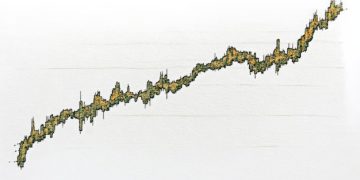Investing in Dividend Stocks: Top 5 Picks for Passive Income

Investing in dividend stocks can generate a steady stream of passive income; explore five promising dividend stock picks that offer a blend of stability and attractive yields.
Looking for a reliable way to generate passive income? Investing in dividend stocks can be a smart move. These companies share a portion of their profits with shareholders, providing a consistent income stream. We’ve curated a list of five dividend stocks that stand out for their potential to deliver solid returns and long-term growth.
Understanding Dividend Stocks
Dividend stocks are shares of companies that regularly distribute a portion of their earnings to shareholders. These payments, known as dividends, can provide a steady income stream, making them an attractive option for investors seeking passive income. Understanding the basics of dividend investing is crucial before diving into specific stock picks.
What are Dividends?
Dividends are payments made by a company to its shareholders, typically on a quarterly basis. The amount of the dividend is usually expressed as a dividend yield, which is the annual dividend payment divided by the stock price.
Why Invest in Dividend Stocks?
Investing in dividend stocks offers several benefits, including a regular income stream, potential for capital appreciation, and a hedge against inflation. Dividend-paying companies are often well-established and financially stable, making them a relatively safe investment option.
- 💰 Income Generation: Dividends provide a consistent income stream.
- 📈 Capital Appreciation: Potential for stock price growth over time.
- 🛡️ Inflation Hedge: Dividends can help offset the effects of inflation.
Dividend stocks can be a valuable addition to any investment portfolio, offering a blend of income and growth potential. By understanding the basics of dividend investing, investors can make informed decisions and build a portfolio that aligns with their financial goals.
Factors to Consider Before Investing
Before investing in dividend stocks, it’s essential to consider several factors to ensure that you’re making informed decisions. Evaluating a company’s financial health, dividend history, and industry outlook can help you identify stocks that are likely to provide consistent and sustainable returns.

Financial Health
Assess the company’s financial health by reviewing its balance sheet, income statement, and cash flow statement. Look for consistent revenue growth, healthy profit margins, and a manageable debt load.
Dividend History
Examine the company’s dividend history to see if it has a track record of consistently paying and increasing dividends. A long history of dividend payments is a positive sign, but it’s important to ensure that the company’s dividend payout ratio is sustainable.
Industry Outlook
Consider the industry in which the company operates and its growth prospects. Investing in companies that are well-positioned to benefit from long-term trends can increase your chances of success.
- 📊 Payout Ratio: Ensure the company can sustain its dividend payments.
- 🕰️ Consistency: Look for a history of steady or increasing dividends.
- 🌱 Growth Potential: Invest in industries with positive outlooks.
By carefully considering these factors, investors can make more informed decisions and build a dividend portfolio that is aligned with their financial goals and risk tolerance.
Top 5 Dividend Stock Picks for 2025
Based on our analysis, here are five dividend stocks that stand out for their potential to generate passive income in 2025. These companies have strong financial health, a history of consistent dividend payments, and favorable industry outlooks.
1. Johnson & Johnson (JNJ)
Johnson & Johnson (JNJ) is a healthcare giant with a long history of dividend payments. The company’s diverse product portfolio, strong financial position, and commitment to innovation make it a reliable dividend stock.
2. Procter & Gamble (PG)
Procter & Gamble (PG) is a consumer goods powerhouse with a portfolio of well-known brands. The company’s consistent cash flow, strong balance sheet, and history of dividend increases make it an attractive option for dividend investors.
3. Realty Income (O)
Realty Income (O) is a real estate investment trust (REIT) that focuses on commercial properties. The company’s monthly dividend payments, diversified tenant base, and strong management team make it a popular choice among dividend investors.

4. AT&T (T)
AT&T (T) is a telecommunications giant that provides wireless, broadband, and entertainment services. The company’s high dividend yield, large subscriber base, and investments in 5G technology make it an interesting dividend stock.
5. Coca-Cola (KO)
Coca-Cola (KO) is a beverage giant with a global presence. The company’s iconic brand, strong distribution network, and history of dividend increases make it a solid dividend stock for long-term investors.
These five dividend stocks offer a blend of stability and attractive yields, making them suitable for investors looking to generate passive income in 2025. Remember to conduct your own research and consult with a financial advisor before making any investment decisions.
Analyzing Dividend Yield and Payout Ratio
When evaluating dividend stocks, two key metrics to consider are dividend yield and payout ratio. These metrics provide insights into the attractiveness and sustainability of a company’s dividend payments. Understanding how to interpret these metrics can help you make informed investment decisions.
Dividend Yield
Dividend yield is the annual dividend payment divided by the stock price, expressed as a percentage. A higher dividend yield indicates that the company is paying out a larger portion of its earnings as dividends.
Payout Ratio
Payout ratio is the percentage of a company’s earnings that it pays out as dividends. A lower payout ratio indicates that the company has more room to increase its dividend payments in the future.
Interpreting the Metrics
While a high dividend yield may seem attractive, it’s important to ensure that the company’s payout ratio is sustainable. A high payout ratio can indicate that the company is paying out too much of its earnings as dividends, which could put its dividend payments at risk.
- 📈 High Yields: Attractive, but ensure sustainability.
- 📉 Low Ratios: More room for future dividend increases.
- ⚖️ Balance: Look for a healthy balance between yield and payout ratio.
By analyzing dividend yield and payout ratio, investors can assess the attractiveness and sustainability of a company’s dividend payments and make more informed investment decisions.
Risks and Challenges of Dividend Investing
While dividend investing offers numerous benefits, it’s important to be aware of the risks and challenges involved. Market volatility, company-specific issues, and changes in dividend policies can all impact the performance of dividend stocks. Understanding these risks can help you manage your portfolio effectively.
Market Volatility
Market volatility can impact the stock prices of dividend-paying companies, leading to capital losses. It’s important to have a long-term investment horizon and avoid making impulsive decisions based on short-term market fluctuations.
Company-Specific Issues
Company-specific issues, such as declining sales, increased competition, or regulatory changes, can impact a company’s ability to pay dividends. It’s important to monitor the financial health and performance of the companies in your dividend portfolio.
Changes in Dividend Policies
Companies can change their dividend policies at any time, which can result in reduced dividend payments or even dividend suspensions. It’s important to diversify your dividend portfolio and avoid relying too heavily on any single stock.
Despite these risks, dividend investing can still be a valuable strategy for generating passive income and building long-term wealth. By diversifying your portfolio, conducting thorough research, and staying informed about market conditions and company-specific issues, you can mitigate these risks and increase your chances of success.
Building a Diversified Dividend Portfolio
Diversification is a key principle of successful investing, and it’s especially important when building a dividend portfolio. By diversifying your investments across different sectors, industries, and geographic regions, you can reduce your overall risk and increase your chances of generating consistent returns.
Sector Diversification
Invest in dividend stocks from a variety of sectors, such as healthcare, consumer goods, telecommunications, and real estate. This can help you reduce your exposure to any single sector and increase your overall portfolio stability.
Industry Diversification
Within each sector, diversify your investments across different industries. For example, in the healthcare sector, invest in companies that focus on pharmaceuticals, medical devices, and healthcare services.
Geographic Diversification
Consider investing in dividend stocks from different geographic regions, such as the United States, Europe, and Asia. This can help you reduce your exposure to any single country or region and increase your overall portfolio diversification.
- 🏢 Sector Variety: Healthcare, consumer goods, telecom, real estate.
- 🏭 Industry Mix: Pharmaceuticals, devices, services.
- 🌍 Global Reach: US, Europe, Asia.
By building a diversified dividend portfolio, you can reduce your overall risk and increase your chances of generating consistent returns over the long term. Remember to rebalance your portfolio periodically to maintain your desired asset allocation and ensure that you’re not overexposed to any single stock or sector.
| Key Point | Brief Description |
|---|---|
| 💰 Dividend Stocks | Shares of companies that distribute earnings to shareholders. |
| 📈 Dividend Yield | Annual dividend payment divided by stock price. |
| 🛡️ Payout Ratio | Percentage of earnings paid as dividends. |
| 🌱 Diversification | Spreading investments across sectors and regions. |
FAQ
▼
Dividend stocks are shares of companies that regularly distribute a portion of their profits to shareholders, providing a steady income stream.
▼
Dividend yield is calculated by dividing the annual dividend payment by the stock price and expressing the result as a percentage.
▼
A good payout ratio is typically between 30% and 70%, indicating that the company has room to reinvest in its business and continue paying dividends.
▼
Diversification reduces risk by spreading investments across different sectors and industries, protecting against company-specific issues.
▼
Risks include market volatility, company-specific issues, and changes in dividend policies, which can impact dividend payments.
Conclusion
Investing in dividend stocks can be a rewarding strategy for generating passive income and building long-term wealth. By understanding the basics of dividend investing, considering key factors, and diversifying your portfolio, you can increase your chances of success and achieve your financial goals.





